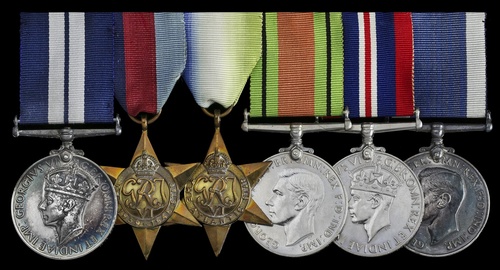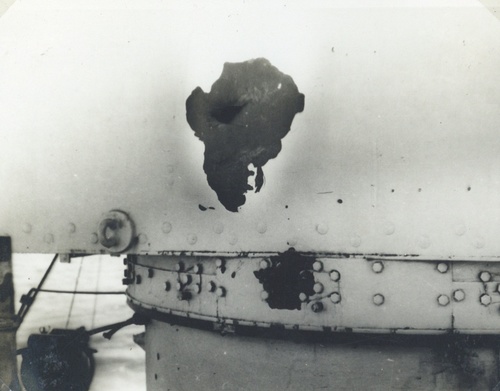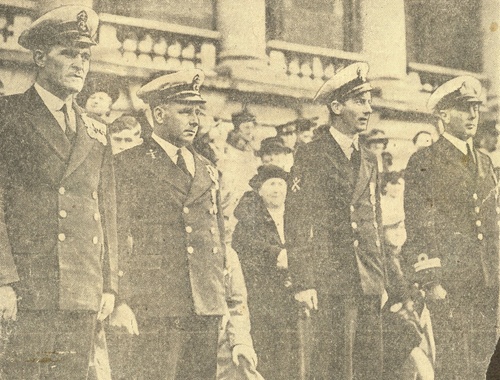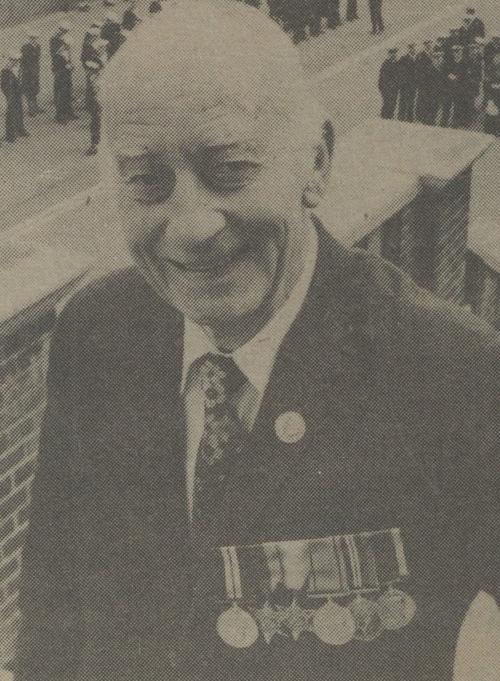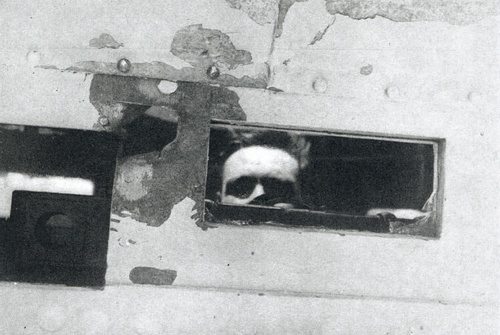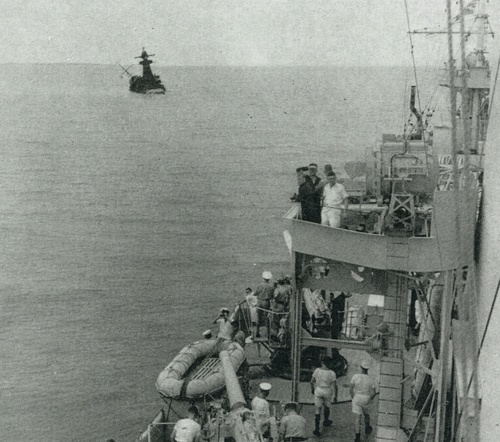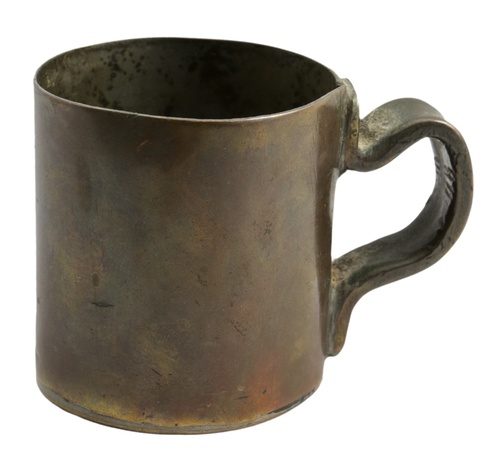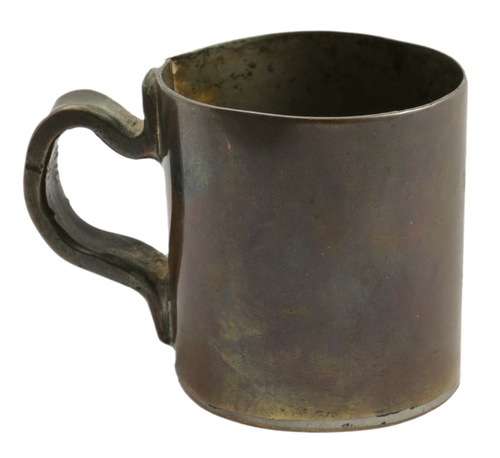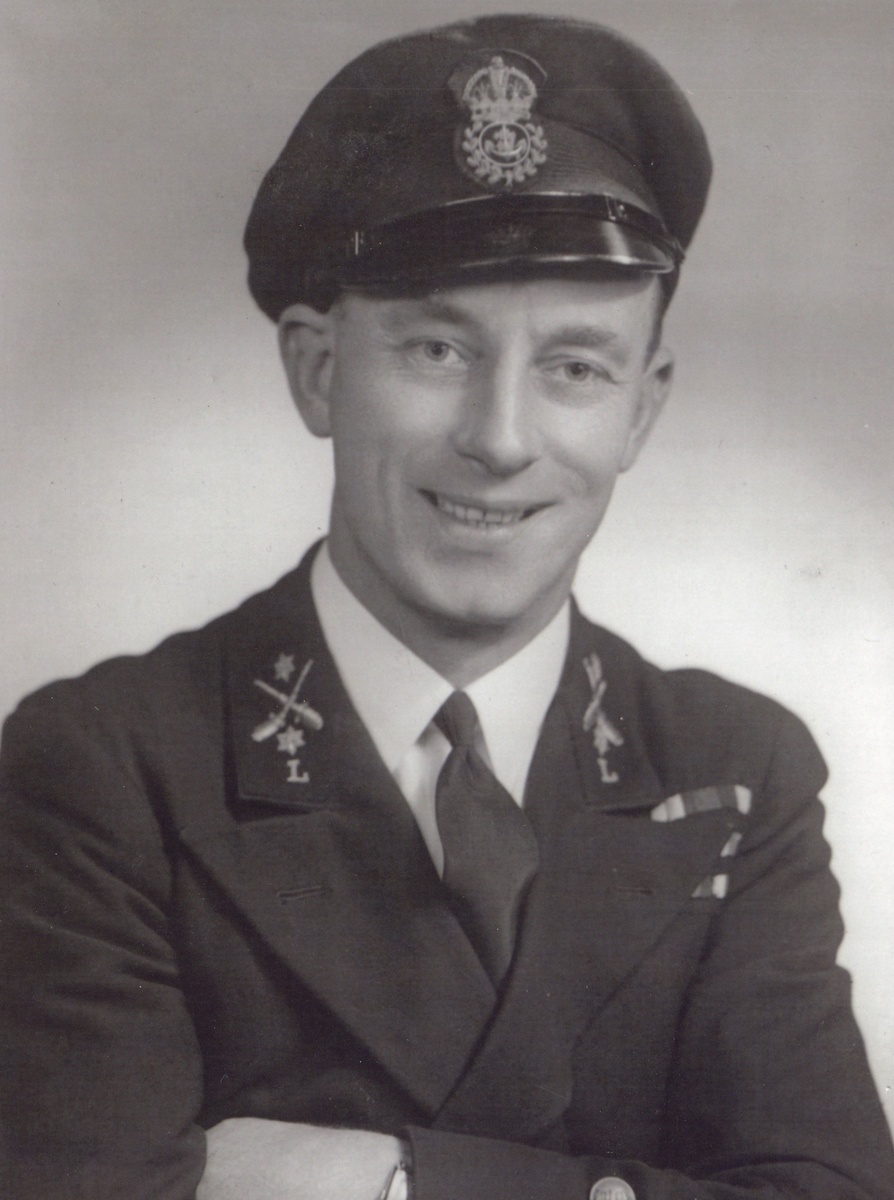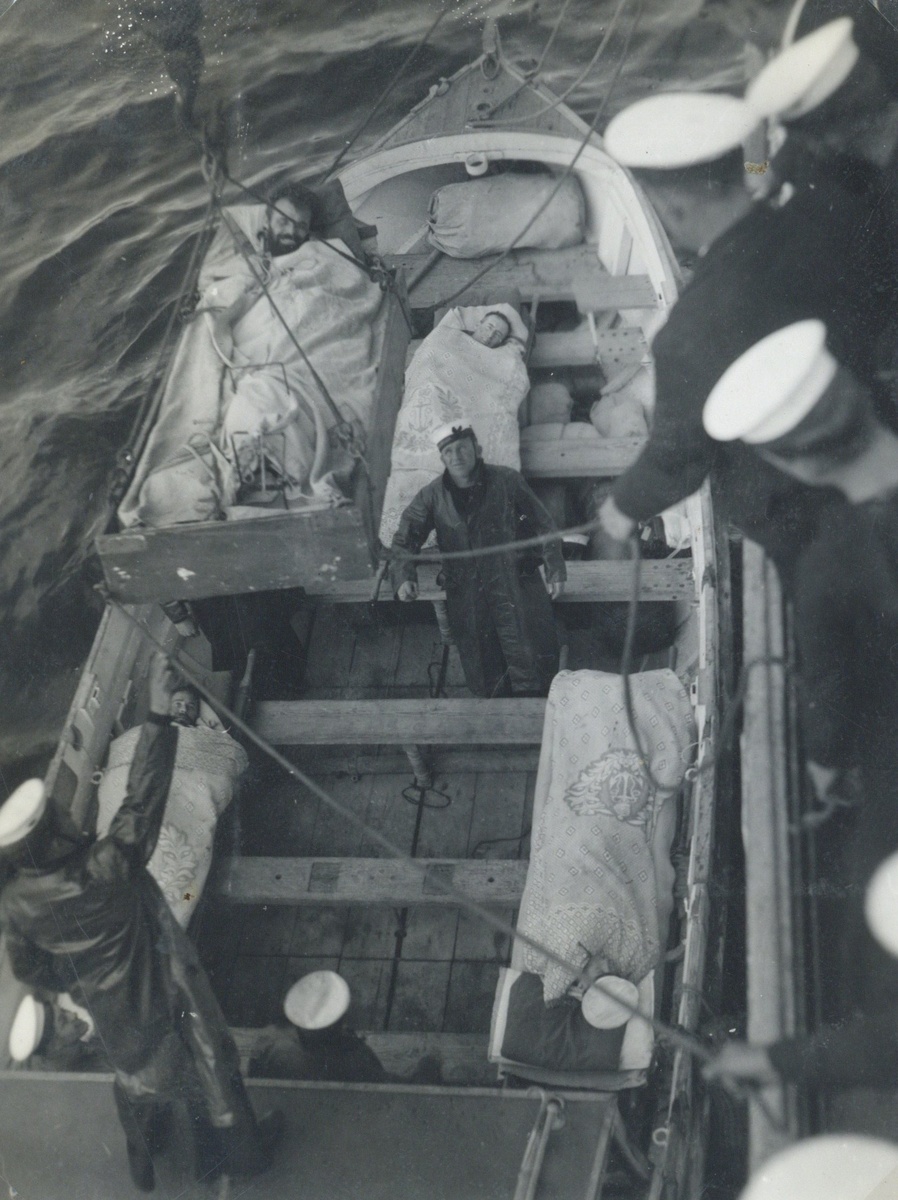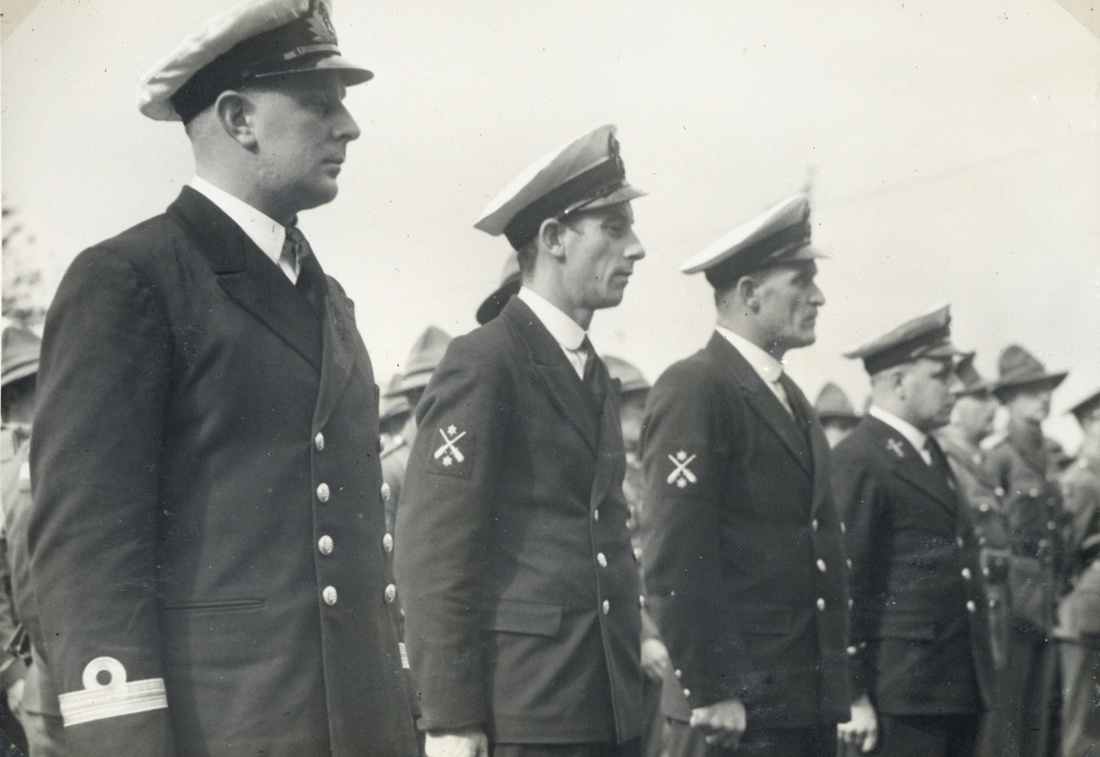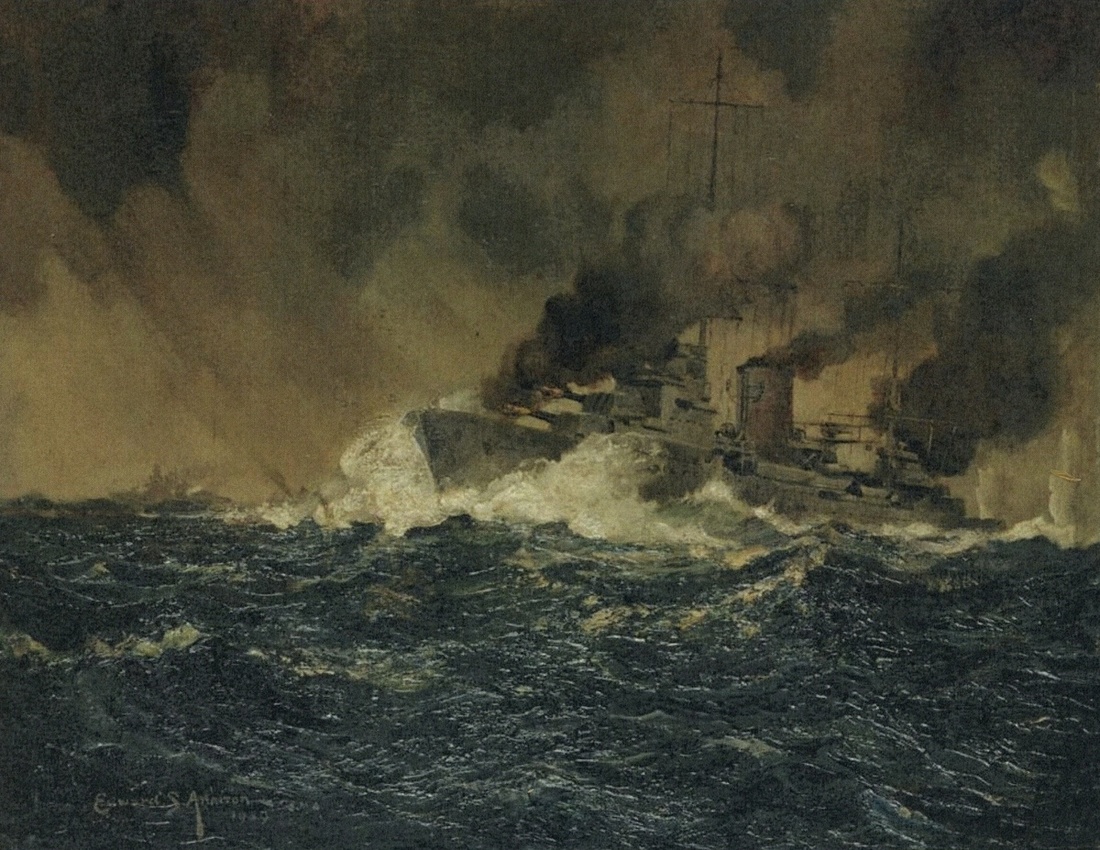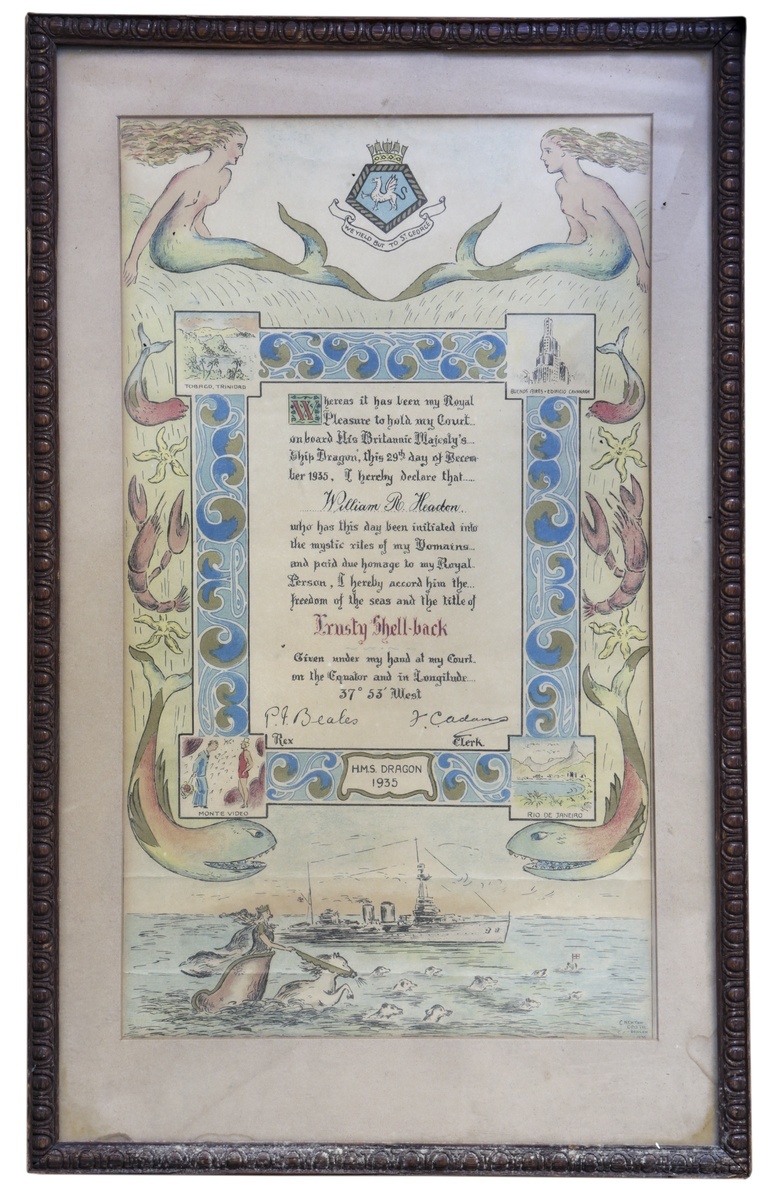Auction: 19001 - Orders, Decorations and Medals
Lot: 528
Sold by Order of a Direct Descendent
'Earlier in the day in London, Churchill had told the War Cabinet at its morning meeting that he proposed to make a recommendation forthwith to His Majesty for some recognition of the gallant action fought by Commodore Harwood and the Captains of the three ships under his command.
Evidently Churchill acted with his usual energy and 'in the dog watches of this evening', Harwood received the Admiralty's signal informing him of the honours bestowed by H.M. the King: for Harwood there was a knighthood and promotion to Rear-Admiral to date from the day of the Battle, and his Captains in Exeter, Ajax and Achilles were made Companions of the Most Honourable Order of the Bath.
Knowing that Harwood's cabin had been blown apart, one cheerful rating was overheard to say, "Order of the Bath? They ain't got a blinking bath between them!" '
Henry Harwood, Hero of the River Plate, refers.
An emotive and well-documented Second World War Battle of the River Plate D.S.M. group of six awarded to Petty Officer W. R. 'Dick' Headon, Royal Navy, who was decorated for his gallant deeds aboard H.M.S. Achilles
When several shell splinters from the pocket battleship Graf Spee struck his Gun Direction Tower in the early stages of engagement - killing four of his men and wounding two others - he nonetheless remained at his post and ensured that Achilles kept up an accurate output of over two hundred broadsides: a fellow Gun Director was awarded the C.G.M. for like services
Distinguished Service Medal, G.VI.R. (W. R. Headon. P.O. C/J. 107927. Dec: 13/39), officially engraved service number and date, as per River Plate awards issued in New Zealand, the remaining details privately engraved; 1939-45 Star (C/J 107927 W. R. Headon. C.P.O. H.M.S. "Pembroke."); Atlantic Star (C/J. 107927. W. R. Headon. P.O. H.M.S. "Achilles."); Defence Medal (C/J. 107927. W. R. Headon. C.P.O. H.M.S. Pembroke.); War Medal 1939-45 (C/J. 107927. W. R. Headon. C.P.O. H.M.S. "Hornbill"), these four privately engraved; Naval L.S. & G.C., G.VI.R. (J. 107927 W. R. Headon. P.O. H.M.S. Pelican.), mounted as worn, good very fine (6)
D.S.M. London Gazette 23 February 1940. A contemporary newspaper cutting of 'The Official Record' states:
'Though early in the action several splinters struck the Gun Director Tower at once, killing three men and wounding two others inside the tower, he kept up an accurate output for a prolonged action of over two hundred broadsides. He was faced with the difficult task in hand training [the guns] with large alterations of course at full speed and with wide angles of rudder. During the lull he helped to remove the dead and wounded.'
William Richard Headon or 'Dick' to his friends, was born at Stroud, Gloucestershire on 1 March 1908 and entered the Royal Navy bas a Boy 2nd Class in August 1923.
By the outbreak of hostilities in September 1939, he was serving as a Petty Officer in the Royal New Zealand Navy's light cruiser, H.M.S. Achilles.
26 September 1939: 'Begin Commerce Raiding!'
Four days after receiving the order from Berlin, the enemy pocket battleship Graf Spee claimed her first victim, the 5,000-ton Booth Line S.S. Clement; the Master sent out the 'RRR' signal - meaning 'I am under attack by an enemy surface warship' - but to no immediate avail. However, similar signals dispatched from her ensuing victims allowed the Admiralty's Operational Intelligence Centre (O.I.C.), to painstakingly reconstruct the Graf Spee's track.
On 2 December, Langsdorff scored his greatest success, stopping the 10,000-ton Doric Star, bound from Auckland to London. Once again, the wireless operator stood by his office and sent out the 'RRR' message. At the O.I.C. it was rapidly deduced, correctly, that this was the same raider who had accounted for the Africa Shell in the Mozambique Channel, and whom had simply returned to her previous hunting ground where she had sunk the Newton Beech, Huntsman, Ashlea and Trevanion. O.I.C's deductions were duly confirmed when Graf Spee attacked the Tairoa on the following day: the hunt was on.
The Correlation of Forces
Up to this point, the identity of the German commerce raider remained unknown to the British, though most thought that she was probably the Scheer; on 8 December, the name Graf Spee appeared for the first time in the Admiralty War Diary in the text of a signal from the British Naval Attache in Buenos Aires.
The pocket battleship Admiral Graf Spee - to use her full name - had been laid down in June 1934 at Wilhelmshaven and was christened by Countess Huberta von Spee, the daughter of Vice-Admiral Count von Spee, who had died during the Battle of the Falklands on 8 December 1914. At 12,000-tons displacement - far more than the 10,000-tons allowed by the Washington Treaty - she was powered by diesel engines with a designed speed of 28 knots. Her main armament was six 11-inch guns in two triple turrets, firing shells of 700 lbs weight, with a maximum range of 40,000 yards, but at a rate of fire of only two or three rounds per gun per minute. Complimented by two quadruple 21-inch torpedo tubes on her quarterdeck, eight 5.9-inch guns and an armoured belt ranging from 3 to 5.5 inches, she was a formidable fighting force.
To counter her recent spate of successes, the Royal Navy devised Force 'G' under Admiral Sir Henry Harwood, Commodore in Command of the South American division of the America and West Indies Station. In command of three ships - the heavy cruiser Exeter and the light cruisers Ajax and Achilles - Harwood knew that the Graf Spee's overwhelming superiority in weight of fire could cripple his little armada with direct hits from long range. For whilst the British ships had an advantage in speed, only the 8-inch shells from Exeter's six big guns could possibly penetrate the Graf Spee's armour; his first task would be to get within effective gun range before any of his three ships were put out of action and his second would be to use skill and tactics to outwit Admiral Langsdorff and divide his fire.
The Rendezvous
Following the demise of Tairoa, Harwood determined that the Graf Spee's next objective was likely to be British shipping on the South American coast. At 15 knots cruising speed, he further determined that Langsdorff could reach Rio de Janeiro by 12 December, the Plate by the 13th or the Falklands by the 14th; more than 1500 miles separated these areas, but the most important of the three was the focal area of the large - and very valuable - grain and meat trade off the River Plate. At 6 a.m. on 12 December, Achilles, Ajax and Exeter met 150 miles east of Medanos Point. The following day they moved to a position 340 miles east of Montevideo and, as day broke, Ajax sighted smoke.
Hardly had the signal to Exeter been made to investigate the smoke than the silhouette of the Graf Spee became clear over the horizon: Captain Bell in Exeter shouted at his gunnery officer, 'There's the f***ing Scheer, open fire on her!' and, a minute later, signalled Harwood, 'Enemy in sight 320 degrees'.
'Make way for the Digger flag!'
Aboard Achilles, a signalman hoisted a New Zealand ensign to the mainmast head amidst to loud cheers. For the first time, a New Zealand cruiser was about to engage the enemy.
Achilles and Ajax continued together north-eastwards to cross the enemy's bows, while Exeter made a large alteration of course to the north, then westwards, so that the enemy would be engaged simultaneously from widely different bearings and from opposite sides. It worked, Langsdorff initially dividing his fire, albeit focussing upon Exeter whom he considered the 'more dangerous opponent'; The Battle of the River Plate: A Tactical Analysis, refers.
Steaming at 25 knots, the Achilles opened up at 06.20 a.m., and Ajax 2 minutes later; their high rate of accurate fire obliged Graf Spee to reply with her 5.9-inch guns. A minute later, Exeter was straddled amidships killing the crew of the starboard torpedo tubes. This was followed by a direct hit on the front of 'B' turret, splinters sweeping the bridge and killing and wounding many, except Captain Bell, who hurried to the after conning position and continued to direct his ship.
At 6.25 a.m., Langsdorff turned to port and northwards, ably followed by Ajax and Captain Parry in the Achilles; whilst developing maximum gunfire, the light cruisers dodged punishment from the enemy's fire by frequent alterations of course. As they closed the range and drew ahead of the German, it was clear that the concentrated fire of their armament was proving a worry. Forced to make smoke, the Graf Spee became increasingly harassed by the two light cruisers, who at 31 knots and firing as fast as they could, created indecisiveness in the mind of Langdorff, just as Harwood had hoped; according to the British Commander:
'After the hits on Exeter, he ought to have finished her off. Perhaps he thought he had, as we did, when she disappeared in a great cloud of spray, smoke and flame. But she came out and remained in the action - her finest achievement - and so the enemy remained undecided.'
At 6.40 a.m., an 11-inch shell fell short of the Achilles, but splinters showered the bridge and the Gun Director Control Tower in which Petty Officer Headon resided. By family repute, Headon had been ordered to 'make a brew' by Captain Parry and thus escaped the fate which befell his comrades. From this point on, Captain Parry was himself wounded and no doubt enraged, and the action became virtually a chase. Despite fire control problems and the loss of the gunnery control wireless, the Ajax and Achilles were 'maddening the Graf Spee' who could only fire intermittently on the British ships, which were obscured by her own smoke. As the lone survivor, Headon also took command of sighting the guns by eye for the remainder of the battle.
By 8.00 a.m., after an hour and a half of action, Harwood was informed that Ajax had only 20% of ammunition remaining and barely three guns left in action. Hauling round, he determined to move out of range and shadow the German, but not before a shell from Graf Spee cut the main topmast of Ajax clean in two.
"We might as well be bombarding her with snowballs!"
To Harwood, the unequal calibre of weaponry and armour was proving extremely frustrating, especially given the valour displayed aboard Exeter to stay in the hunt and the sheer bloody mindedness of his little cruisers. However, the German report of the damage, especially to the upper deck of the Graf Spee, filled ten pages of the Gefechtsbericht, or battle report. There were many dead and wounded, the latter including Langsdorff himself, who had fought his ship from the exposed flying bridge; he had been wounded twice, once in the arm, and again when he was blown to the deck and concussed.
More concerning was the hole in Graf Spee's bows, the destruction of the galleys, the loss of flour for baking, fresh water, and varying reports about the amounts of useable fuel left. On a personal level, it seems that his morale collapsed, and on returning to the bridge, he told his navigating officer, 'We must run into port. The ship is not now seaworthy for the North Atlantic'; Henry Harwood, Hero of the River Plate, refers.
A failed delaying ruse
Off the Plate, Ajax and Achilles received a wireless signal, likely from the Graf Spee: 'Please rescue lifeboats of English steamer.' Neither cruiser replied and, as they passed the merchantman British Shakespeare, they were delighted to see that her boats remained stowed and hear that assistance was not required. The enemy's ruse had failed and the shadowing process continued, the adversaries continuing to exchange sporadic salvoes until, after midnight, the Graf Spee anchored in Montevideo Roads, her superstructure silhouetted by the lights of the Uruguayan Capital.
So ended the day-long chase during which the modern pocket battleship, after putting Exeter out of action and partly disabling Ajax, had refused to fight at close quarters and had fled to a neutral harbour. Throughout the day and the hours of darkness, Exeter, Ajax and Achilles, by their discipline, their fighting energy, their readiness to take risk and punishment, the competence and team-play of their Captains, their self-assurance and confidence, all under Harwood, had gained a victory in one of the most brilliant cruiser actions in the long annals of the Royal Navy.
The final throw of the dice - a masterful deception
On Sunday 17 December 1939, the Graf Spee left harbour at 6.15 p.m. with a skeleton crew, and scuttled herself two and a half hours later, believing a far superior British force to be awaiting her in International Waters. This was not the case. According to contemporary reports: 'A fierce jet of flame leaped from the doomed ship, followed by a dense cloud of smoke and a loud rumble of an explosion.' Fires continued to burn in Graf Spee for six days; Langsdorff chose suicide on 20 December, whilst his ship still lay alight.
Their job done, Headon and the Achilles travelled to New Zealand where the ship was repaired and refitted; during the six months since she had left Auckland in August 1939, she had steamed over 50,000 miles and spent 168 days at sea. Joined by Harwood, who popularly negotiated the move to Auckland rather than to Malta, as originally scheduled, the men cheered and serenaded their Commander with 'For He's a Jolly Good Fellow': over 100,000 New Zealanders greeted the ship's company as she came into port.
The Battle had cost Exeter 61 dead and 23 wounded, Ajax 5 dead and 5 wounded, and Achilles 4 dead, all of them killed in the Gun Direction Tower with Headon. Aboard the Graf Spee, 36 had died and 60 were wounded.
Headon, who received his D.S.M. at an investiture held at Wellington, New Zealand, returned to sea with an appointment in H.M.S. Pelican and later served at various shore establishments; he was released Class 'A' on 30 April 1948.
Sold with a comprehensive archive of original documentation and photographs, comprising:
(i)
A large album containing original documentation relating to the recipient's career, including his first call-up paper, dated 7 August 1923, and early portrait photographs in naval uniform; a Christmas card from Headon aboard H.M.S. Velox, 1926; General Passing Certificate as Leading Seaman, dated 1 July 1927; examination result sheet, passing Headon for P.O. aboard the cruiser York, dated 17 January 1936; telegrams of congratulation regarding the announcement of the D.S.M., with newspaper cutting showing Headon in line prior to being decorated by the Governor-General, Lord Galway, in Wellington; further letters of congratulation, including one from G. F. Clarke, R. N. Barracks, Chatham, on 15 January 1940: 'WELL DONE THE ACHILLES. Damn good show. Reckon you enjoyed yourself at the director, showing the boys how well that the Chatham layers can lay.'
(ii)
An appealing colour 'Crossing the Line' certificate to William R. Headon: 'I hereby accord him the freedom of the seas and the title of Crusty Shell-back, Given under my hand at my Court on the Equator and in Longitude…. 37' 53' West.' Design by C. Newton, C.P.O. Tel., H.M.S. Dragon, 1935, framed and glazed; together with copied typed documentation appertaining to Headon appearing before Court to pay Homage to Neptune, dated 27 December 1935.
(iii)
Photograph Album No. 1, offering an account of life aboard H.M.S. Cyclamen from 1929 to 1932, including an extensive deployment to the Persian Gulf and return journey via Kenya and South Africa; approximately 80 photographs and postcard photographs.
(iv)
Photograph Album No. 2, detailing life aboard H.M.S. Dragon from 1935 to 1937, firstly as the ship travelled south from Bermuda and down the east coast of South America towards Buenos Aires; images of Trinidad, Ceará and Bahia in Brazil - including the Graff Zeppelin passing over Dragon - and Buenos Aires. The album also contains photographs of New York, Boston and Quebec, before focussing upon the British West Indies, Jamaica and Mexico in 1937; approximately 230 photographs and postcard photographs, together with a contemporary newspaper article detailing the welcome of Dragon to St. Petersburg, Florida.
(v)
Photograph Album No. 3, containing a fascinating archive relating to the Achilles and the pursuit of the Graf Spee towards Montevideo; commencing with a formal photograph of Admiral Harwood and the Officers of Achilles, the album also contains photographs of Captain Parry on the bridge, damage to the Control Tower and subsequent lowering of the wounded, and the crew of 'A' turret relaxing after the action. It goes on to show the Graf Spee anchored at Montevideo, the dead lying in coffins draped with the German flag, damage to the hull caused by an 8-inch shell, a burnt-out seaplane aboard the ship and Captain Langsdorff in discussion with the German Consul. Further images include Langsdorff saluting the dead, wreaths laid out, and the funeral cortege, together with a parade of the German sailors before their departure to Buenos Aires. The album concludes with images of damage to the Achilles, including one showing Captain Parry's private cabin - which was struck heavily by shrapnel - and a number noting 'blistered' guns. Carefully annotated, in one example, '"I" was behind "That" hole', the album ends by detailing the warm reception from crowds of well-wishers at Auckland and the presentation of honours at Wellington; including original Luncheon Menu, 'Civic Welcome to H.M.S. Achilles', Christmas 1939 Menu held aboard ship, and newspaper cuttings; approximately 95 photographs in total, many personally taken by Headon and hitherto unpublished, and thus of historical significance.
(vi)
A typed manuscript document, annotated to first page, 'Petty Officer Richard Headon. D.S.M., Achilles,' and titled 'Letter from the Captain of "Graf Spee" to the German Minister at Montevideo. Battle of the River Plate. 13th Dec., 1939.'; approximately 8 pages detailing communications between Captain Langsdorff and Herr Otto Langmann, diplomatic activity, the arrival of the Ark Royal and Renown at Rio de Janeiro, and awareness of the situation in Berlin.
(vii)
A framed portrait photograph of Headon as a C.P.O., together with a later colour photograph of his godson aboard the Océanis 311 Clipper Richard Headon of Ipswich, named in honour of his godfather.
(viii)
Two small photograph albums, titled 'Snapshots' to front cover; containing further images from New Zealand with a focus upon the Maori peoples, and also images of naval crews and family members, notably his wife.
Also included are the following related artefacts:
(i)
Cigarette cases (2), the first silver, engraved to cover, 'W. R. Headen (sic), from Waipawa Boys 1940'; the second E.P.N.S., monogram, 'RH' to cover and dated 1.5.40; together with identity bracelet by Swank, in average condition commensurate with use and general wear.
(ii)
A 50th Anniversary of the Battle of the River Plate 1939 - 1989 commemorative fine china mug by Heron.
(iii)
An original brass rum measure from H.M.S. Achilles, the contents carefully guarded by the sailors aboard!
Subject to 20% VAT on Buyer’s Premium. For more information please view Terms and Conditions for Buyers.
Sold for
£8,000

